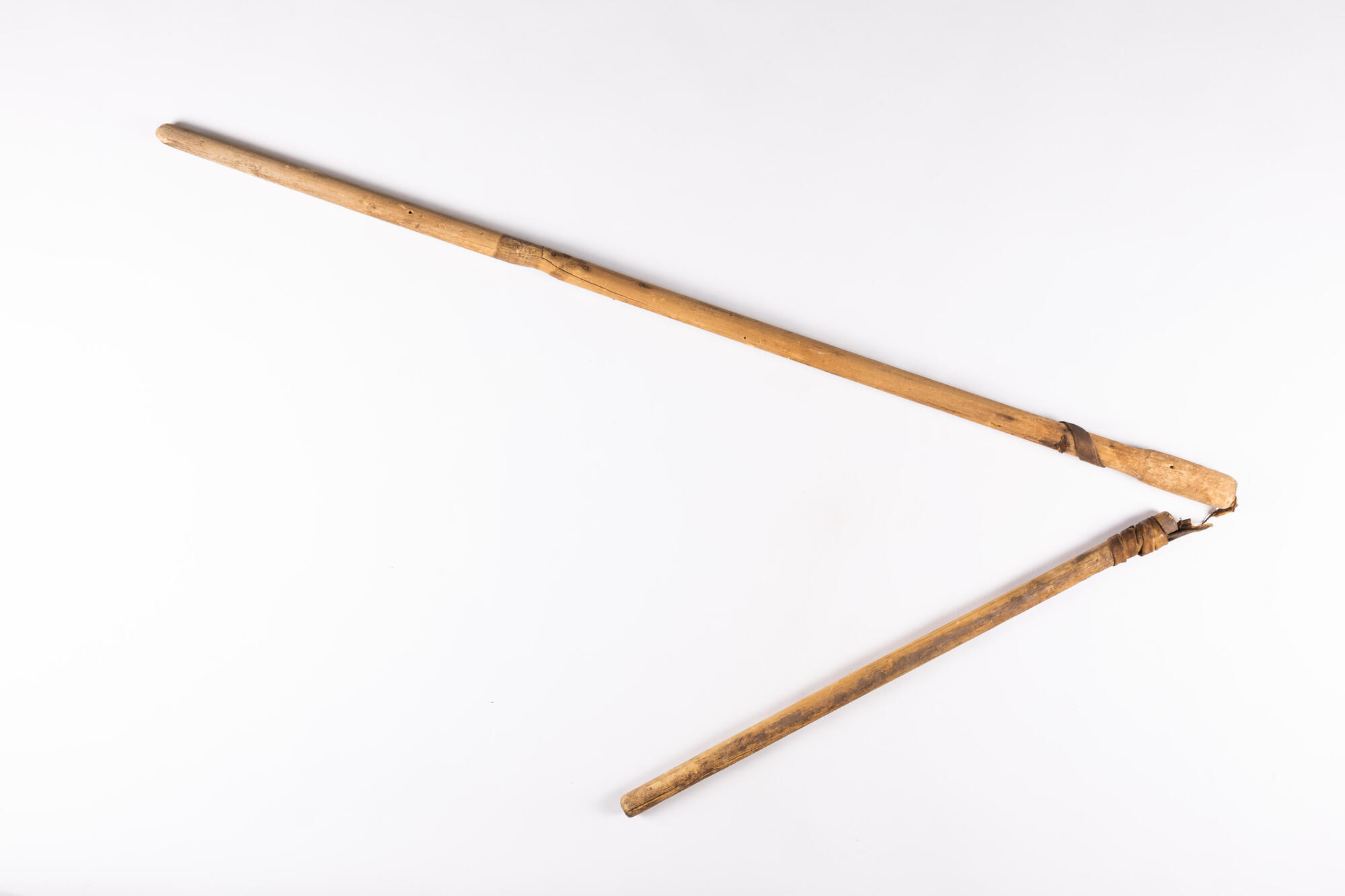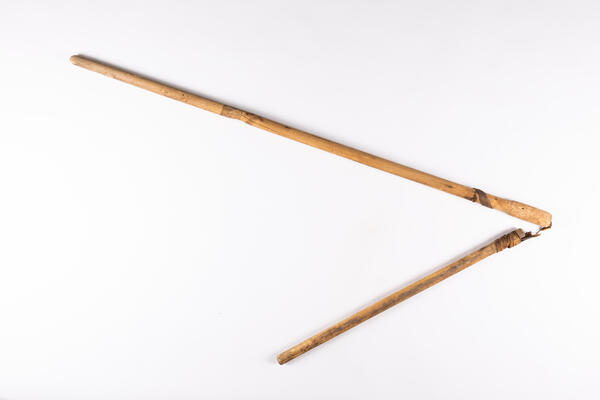This antique flail is an agricultural tool that was used in the past for threshing, i.e. separating the edible part of the grain from the rest of the crop. Traditionally, a flail was made out of two or more sticks that were jointed together in a way that allowed their ends to remain flexible.
The longest stick was used as a handle. It had different names in different regional dialects: kevyo, cherenok, rukoyatka (handle), batog, tsepilnik (flailer), derzhalka (holder), tsepishche, or kadka. Such handles were made out of light-weight timber. The shorter end of a flail, which was used for the actual threshing, was known as dubinka (club), molotilnik (hammer), tepinok, bich (whip), bilo (beater), or bitok. This club’s unattached end was thicker, which significantly increased the force of the impact. This part of the flail was made out of more durable timber like oak wood. The link between the two, which was referred to as khomut (yoke), navyaz' (bind), svyaz' (link), gub, puto (shackle), or putse, was made out of a sturdy belt or common rope.
The flail type used in Rus' Minor (the modern-day Ukraine) had a more complex structure than their northern counterparts. Specifically, the handle and the club were tied together by several strips of leather or hide called kapitsy. The kapitsy, in turn, were joined by a special loop.
In ancient Rus', people went to the gumno—a special room where corn was kept after reaping—in order to thresh the grain. The threshing floor itself was known as tok. About four to eight flails were needed to go through the whole harvest. The workers had to keep up with a certain rhythm in order not to get in each other’s way. Threshing was something that both men and women could do; even children over 12 helped out. Children’s flails were lighter and more compact.
The traditional Bashkir flail had two elements. The first was a lightweight rod that could be over a metre long. One of its ends was thicker than the other, with a special socket. The leather strap that was inserted in this socket connected the rod’s thick end with the club. The club was about 35 centimeters long and crafted out of resilient wood like elm, birch, or oak. The leather moved within the socket without twisting, which was vital for proper threshing. Sometimes, the carved socket was replaced with a circular groove, while the leather was replaced with a hemp rope.
The longest stick was used as a handle. It had different names in different regional dialects: kevyo, cherenok, rukoyatka (handle), batog, tsepilnik (flailer), derzhalka (holder), tsepishche, or kadka. Such handles were made out of light-weight timber. The shorter end of a flail, which was used for the actual threshing, was known as dubinka (club), molotilnik (hammer), tepinok, bich (whip), bilo (beater), or bitok. This club’s unattached end was thicker, which significantly increased the force of the impact. This part of the flail was made out of more durable timber like oak wood. The link between the two, which was referred to as khomut (yoke), navyaz' (bind), svyaz' (link), gub, puto (shackle), or putse, was made out of a sturdy belt or common rope.
The flail type used in Rus' Minor (the modern-day Ukraine) had a more complex structure than their northern counterparts. Specifically, the handle and the club were tied together by several strips of leather or hide called kapitsy. The kapitsy, in turn, were joined by a special loop.
In ancient Rus', people went to the gumno—a special room where corn was kept after reaping—in order to thresh the grain. The threshing floor itself was known as tok. About four to eight flails were needed to go through the whole harvest. The workers had to keep up with a certain rhythm in order not to get in each other’s way. Threshing was something that both men and women could do; even children over 12 helped out. Children’s flails were lighter and more compact.
The traditional Bashkir flail had two elements. The first was a lightweight rod that could be over a metre long. One of its ends was thicker than the other, with a special socket. The leather strap that was inserted in this socket connected the rod’s thick end with the club. The club was about 35 centimeters long and crafted out of resilient wood like elm, birch, or oak. The leather moved within the socket without twisting, which was vital for proper threshing. Sometimes, the carved socket was replaced with a circular groove, while the leather was replaced with a hemp rope.



